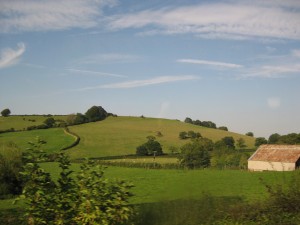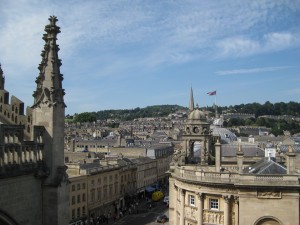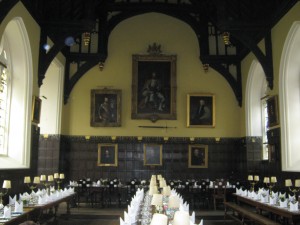September 14th, 2010 · No Comments
I think that some of my favorite activities we’ve done since we’ve been here have been our day trips to Bath, Oxford, and Stratford. I don’t think I could ever live in a city permanently; the crowds, the chaos, the push and shove hustle and bustle in London would definitely be too stressful for me to handle on a long term basis. Driving through the countryside on our way to our destinations was a refreshing break for me, and was much more reminiscent of home than our lives in the city. Below is a picture I took through the bus window on our way home from Bath.

There are several key differences I have observed between London and the smaller cities of Bath, Oxford, and Stratford. Let’s begin with visuals. First is a picture I took from halfway up to the top of Bath Abbey looking out over Bath. Next is a picture I took from the top of St. Paul’s Cathedral looking out over London.


Striking difference, isn’t it? The first major difference I noticed is illustrated by these pictures. London is extremely chaotic, with Gothic churches next to modern office buildings next to museums next to hotels created in Georgian architecture next to parks with no particular rhyme or reason and no grid pattern to the streets. Each of the smaller cities we visited seemed planned. The streets were laid out in straight lines; coming back from the church to the bus in Stratford we were easily able to just reverse our steps and when John said that the coach was straight down this block, it actually was straight, and the name of the street stayed the same all the way down. Houses were grouped with houses and businesses with businesses. You can see this in my photo from Bath – nice rows of houses on the horizon. Finally, each city seemed to have a unifying theme. In Bath, it is the distinctively colored Bath Stone. In Oxford, it is the many colleges. In Stratford, it is the Tudor architecture and the fact that all the streets, hotels, and pubs are named after something Shakespearean. (You could argue that that last theme is a bit kitsch, but still, it is a theme.)
You can also see from the pictures that the buildings in Bath are a lot shorter than the buildings in London. In Bath, the tallest feature is a spire, like it used to be in London. In London, the skyscrapers on the horizon, each one striving to be taller than the last, demonstrates the individualistic capitalism and commercialism that has touched this city more than others. Our day trips have reminded me how London truly is the financial and cultural capital of the world, a place which draws people, a place where things always have to be happening. Bath, Oxford and Stratford seem to be less touched by this globalized commercialism. I did spot a Ben and Jerry’s in Bath, but I did not see Starbucks and KFC’s on every corner like we do in London.
I think that a slower pace of life and a greater appreciation for people goes hand in hand with the softened touch of commercialism in the smaller cities. I think a good example of this contrast is seen by comparing busking in Bath and London. From what I learned from our tour guide in the Bath Abbey, the buskers have their own kind of community. In Bath, you don’t need a license to perform in the streets, but you are only allowed to stay in the same place for one hour before you have to move 50 metres down the street. The buskers regulate this themselves; they form their own queues and rotations for different spots throughout the city. In London, buskers need a license, and they are assigned a specific spot and specific time to perform. It is doubtful that many of them know each other or even cross paths. Furthermore, in Bath, people sit around the squares and actually listen to the busker perform for the entire half hour or hour he is there. In the London Underground, people always hurry right past the performers, barely noticing them. In the smaller cities, I felt like there were actually people, as opposed to the anonymous mass we have observed in London.
Personally, I prefer the smaller towns and cities to London, but they are not without their disadvantages. Obviously, there is not as much diversity to be found in the smaller cites, nor are there are many opportunities for arts and museums as there are in London.
A problem with the argument I have made in this post is that the three smaller cities we’ve gone to have also been very touristy cities. Although I feel as though the observations I have made are accurate, I recognize that they are limited by the presence of tourists queuing for attractions and buying gifts in gift shops. I am excited to move to Norwich, a less touristy town and one in which we will actually get to participate in the communitiy, to see if my observations hold true.
Tags: 2010 Kaitlin
January 22nd, 2010 · 1 Comment
So this is by no means what I am doing or my presentations; however, I felt it would be of interest to you folks anyway. Over winter holiday, I went to visit the MHS (Museum of the History of Science) to see their exhibit on the art that has come out of steampunk movement, both and England and worldwide. It was fantastic, and I definitely recommend it as it is running until February 21st.
For most people, the idea of steampunk (and the movement surrounding it) is quite foreign, so I will do my best to explain what I believe it to be. I stress that this is strictly my interpretation, as it is a severally decentralized idea with many interpretations. The way I see it there are three major aspects of steampunk. The first being the history surrounding it. The second is the art that has come from it, both literature, music and painting. And the third, is the DIY(do it yourself).
It is difficult to pinpoint when “steampunk” first originated. The OED places the term steampunk around 1987 by Jeter in Locus; it being based off of the previous genre of cyberpunk, which is is an entire different subject. Despite its fairly modern coinage, steampunk has arguably been around since the Victorian era (whence it is based). Works from Jules Verne to H.G Wells sought to look into the future of technology, using what understanding they had around them. In more modern works, steampunk looks at modern technology and wonders how the Victorian era would have created it. How would our society have benefits or been illed if the social atmosphere of the 1800s had continued to present day?
As the art exhibit showed, steampunk is still inspiring people today to push the boundaries of what art is. There were beautifully remastered keyboards, fitted with wood panels and type-writer letters, a light fixture that was simply amazing. There were, however, less practical aspects such as a teleportation device. This blending of functionality and impractically is a keystone of the steampunk dogma. It doesn’t truly matter if something makes sense; it is almost as if steampunk asks us to question the rationality of our modernity.
The exhibit itself is very well laid out and organized, and it is a great forum for learning more, seeing its capabilities, and talking with international artists about their motivations and techniques. If anything it was great simply for the people-watching aspect. I will not embarrass myself by putting up the picture of my get up, but needless to say I went in full nerd glory. What was nice about the experience was that dressed up and not dressed up basically gave each other the same looks of curiosity– anthropologists observing a foreign culture. It felt as though there was a mutual understanding of appreciation and acceptance.
What I found most amusing about the whole experience was the music that has come out of the steampunk movement. As with many DIY groups, the instrumentation was weird to say the least. While it wasn’t at the show this guitar is probably one of the neater things I have seen. You even have entire bands devoted to steampunk such as Abney Park.
Do it yourself comes into play for obvious reasons as there isn’t really a plethora of steampunk outlets. But it also works as a means of expression. Once you’ve sown together your first frock coat, or even your first button, there is a strange sense of pride seldom found in modern activities, not unlike finishing a painting or running a 5k. Obviously with our budges as they are arts and crafts probably aren’t on the top of anyone’s list, but it is interesting to see how much you can create with recycled goods. While it is by no means on par with Dickinson’s removal of the lunch trays (or the creation of a sushi bar), I would argue that steampunk is up there in the sustainability zone.
I think my only quarrel with the whole idea is that people often forget about the societal norms of the Victorian era. As we have learned there certainly were social reform movements going on through Queen Victoria and Prince Albert such as the opening of parks and the support of artistic movements. Overall, however, the Victorian era was set by ridge social ques and mass oppression. At the exhibit a young female artist tried to explain to me how the Victorian era was a period of femenistic empowerment, which is absolute bollocks. The idea of sexual equality is something only sense in period pieces when a director needs to have a head strong, coy female lead so as to attract a larger demographic (cough Guy Ritchie cough). For that matter, sexuality in general was severally hampered. Showing your calves, man or woman, was considered an outrageous fopaux.
Much as its brother genres of the science fiction realm, it allows us an interesting thought-experiment and temporary escape. But the modern interpretation of steampunk has drifted further away from its Victorian roots. This decentralization is both a blessing and a curse, as it allows for vast array of artistic expression. It is for that reason that it is so amazing something like the exhibit at the MHS could have been put together and still seem cohesive.
If you’d like some more info on steampunk feel free to ask me anything. I don’t claim to know too much, so here are some sites that know better.
http://www.steampunkmuseumexhibition.blogspot.com/
http://brassgoggles.co.uk/blog/
cheers
Tags: Andrew R
September 7th, 2009 · 2 Comments
During our time in London, we have noticed that many of the religious institutions we have been visiting rely on gift shops and cafés to increase revenue. Some basic internet research shows that many people have mixed feelings about whether or not this practice is acceptable. Generally speaking, we do not believe it is necesarily inappropriate for a church or temple to sell refreshments or gifts related to the location or religion. Given a decrease in European religious sentiment and worldwide economic difficulty, donations aren’t a very reliable source of funding. If a place is to be kept open to a public (tourists and worshipers alike) it needs money to run. Employees and utilities need to be paid and maintenance isn’t cheap. It’s easy to understand the rationale behind the decision to open a shop.
For the most part, the places of worship we have visited had signs informing the guest that the proceeds from the shop or café benefit either local charity or the building itself. For example, St. Martin’s in the Fields’ gift shop benefits “the work” of the church. Additionally, the products sold are related to Christianity, the church itself, and the church’s location. Furthermore, the Shri Swaminarayan Mandir‘s gift shop sold incense, prayer beads, and other products Hindus would need for everyday use in addition to more “touristy” items. We consider all odthese items to be appropraite for such a shop; they are directly related to the place and its purpose.
Whilst visiting the Christ Church College in Oxford (this may or may not have been related to Harry Potter), we stumbled into “The Cathedral Shop” adjacent to the college’s chapel. Most of the items sold by this shop were very similar to the other gifts shops we previously encountered. There were chalices, books, t-shirts, postcards, etc. There was a fairly modest Harry Potter section relating the the films that were partially created at the location alongside a small section dedicated to Lewis Carroll’s Alice in Wonderland, which was written in Oxford.
However, we did notice a few items that did not seem appropriate for a shop entitled “The Cathedral Shop.” Instead, they seemed to be trying VERY hard to appeal to young, hip buyers:

The last time we checked, no religion condones binge drinking and sleeping until 4pm and Oxford isn’t particularly famous for its hangovers.
We’re curious to see what everyone else in the group thinks about the idea of gift shops in religious buildings and what kinds of items they should sell.
Tags: Alli · Churches and Cathedrals · Sarah
All I could think about when I was at Oxford was: “what a privilege”. What a luxury it must be for the students that come here, to be in a university which is in the top ten best universities in the world, to be a Rhodes scholar. Not that I do not appreciate the education I receive, but Oxford University is the most idyllic place I have ever seen. When looking at the gardens of the beautiful colleges, the bikes, the lovely stone buildings, I could almost see the students from the 18th century discussing their ideas at the quad, wearing tweed jackets and going punting in the river.
Of course, this privilege has, traditionally, only been enjoyed by those that grew up privileged. Most of the students at Oxford attended what we know as private schools. This is something else I learnt about England: state schools are what we consider to be private schools. Yes, it’s really complicated. But as I was mentioning, admissions to Oxford still continue to be controversial, specially after the Laura Spence Affair in 2000. Spence was a state public school student who had perfect grades in all of her GCSEs and A-levels, something that would secure her a place in Oxford for sure, but in the end, did not get in. Oxford said that it was because she did not show potential, but people say it was really because of her northern England working class and state-school background. Finally she ended up getting into Harvard with a full scholarship.
However, I realize that, in the end and in the long run, it doesn’t really matter whether education is very expensive, or for free. Higher education is a right and not a privilege in many countries, yet there is many people who just cannot afford the time to go to university and need to start working instead. A student has to be able to afford the time to study.
On another note, I think it will be interesting to compare Oxford with UEA later on, specially because, as I understand it, they have very different structures as institutions of higher education.
Tags: Azul
After visiting two different temples and observed two different cultural groups in their own religious institutions, we must wonder, how are we going to think of them? We must now think about our small overt participant observation because the politics of representation are extremely important. Our impressions of Catholicism, Sikhism and Hinduism should not the participants, the Other, as exotic, or a romanticized version of them. Although it is true that we are always somewhat biased, we can make the effort of being less so by informing ourselves, carefully listening, and above all, observing in a critical way.
Karl Marx once said that religion is the opium of the people. Anthropology however, has said that while religion is a social institution that appeals to every individual in a society, each one at the same time makes his or her own meaning of religion. Religion, as a component of culture, that is, the practice of beliefs, is always changing. It adapts to the passing of time, and especially to globalization processes. England is one of the best examples to understand how cultural practices adapt in a different way when in a different country. What I considered to be the most valuable lesson of the whole experience, is actually proving by looking these places of worship, that different religions, from a sociological standpoint, are the same.
On the last three days here in London, we saw how religion has moved many people throughout the centuries, starting in Oxford University, the birthplace of the British academia, which was founded by monks, and where every College had its own chapel. To this day, the chapel of your college remains the most important place of congregation if you are a student at Oxford. Even in what we consider the “secular Western world”, religion is still very much important.
In the case of the Sikh and Hindu temples, what struck me the most were our guides. The discourse was so alike in so many ways. It always amazes me how every religion claims to provide the ideal lifestyle, and to appeal to everyone across society, and to be the most comprehensive one. It is clear that every people wants to be “the chosen people”.
Some people think that we are always biased. Following many social scientists, I will claim that we must locate ourselves in the context in which we are observing our subject and not think that our experience can be representative of The Sikh, or The Hindus. Who are these guides? What has their experience been with their religion? Would we be observing different cultural practices in a Hindu temple in Nairobi or some other city in another country? In that sense, I wish we could have learnt more about how the cultural practices of these religions have adapted in time, and to the city of London. But for that, further research would be required.
Tags: Azul
I try not to be biased against a museum’s collection because of its particular layout, especially one as restricted as Sir John Soane’s, but I feel that Mr. Soane’s museum was just too prohibitively small to have the kind of impression that he himself wanted it to. The stated purpose of John Soane (an architect by trade) turning his home into a museum was to “preserve [his] house and collection for the benefit of ‘amateurs and students’ in architecture, painting and sculpture.” Rather than gain any further concrete knowledge of these subjects at the Soane, I felt cluttered by what just instinctively felt like cartoonish opulence.
The signage was so sparse that I learned about one in ten of the individual objects rather than collections as a whole and how they relate to Soane or his areas of expertise. I doubt an audio tour would have even been able to cover much of the collection, either. I did get a sense of the importance of Mr. Soane’s work itself, but even this part of the museum consisted of many of his drawings gave me no sense of the arc of his career or his greater role in architecture. As I addressed in my V&A post, an eclectic collection is not enough to doom a museum to failure, but the Soane just fails to create any concrete impression on its guest besides the feeling of being overwhelmed by amazing and historic things.

Rowing graffiti at Corpus Christi College
Oxford is overwhelming in a much better way, if that makes any sense. I won’t speak for the group that did not have a good guide, but I think I got as good a sense of the past and present at Oxford (which are pretty much the same) as one can get when students and faculty are not there. I was glad at first to not be going to Oxford when classes were in session (so as not to be a gawking tourist), but now I wish I’d been able to see Oxfordians (Oxforders? There’s probably a much cooler name than those that us outsiders aren’t supposed to know) interact with the place. Don’t get me wrong, I was delighted to admire the buildings on their own (particularly the dining halls, which are even more stunning than in movies like Chariots of Fire [actually I think that’s at Cambridge]), but going when the University was entirely empty almost made it seem like a museum made from an abandoned University rather than one of the current greatest academic institutions in the world.

The Dining Hall at Oriel College
All of this will help me decide when to go to Cambridge, as will my desire to stay away from tourists there for the shopping. Although I walked around and saw plenty of the University before the tour, I didn’t really believe I was in Oxford until I entered that quad at Lincoln College and felt shut off from the street performers, KFCs and the like. I wonder how the sheer volume of tourists affects students’ ability to have a truly authentic Oxford experience like their predecessors (Brandon asked something like this, but I think our guide was confused). Similarly, I wonder if the cache of living in Oxford has driven housing prices so high that many of those who work at the University must live farther away. All things to explore when I make another pilgrimage one day.
Tags: Aidan
When people hear the word Oxford, they think of a very selective and highly demanding school. And it’s true; the University of Oxford is an elite institution. However, Oxford usually doesn’t conjure up images of the town itself. I will not deny that parts of the town were beautiful, but many parts were a bit too touristy. At certain points throughout Oxford I felt as if I was just walking through a series of strip malls. Such sights were not what I expected Oxford to look like at all; instead I thought I would be seeing just a picture perfect small college town.
On top of this, those “lucky” enough to have been with a certain tour guide are aware of how boring Oxford can be made to be. I know our tour guide had the best intentions, but the manner in which he toured us around Oxford made me want to fall asleep. If that is a glimpse of the Oxford experience, I’ll gladly take Dickinson.
That said, the colleges of Oxford are amazing. The architecture is beyond belief and to have the opportunity to study at one of the colleges would truly be a privilege. The dining hall we visited was extraordinary and surprisingly cheap to eat at (3 pounds for a meal if I remember correctly). Speaking of prices, I have to say that the price of tuition caught me off guard. To pay only 9,000+ pounds in order to attend this elite institution is something I am still trying to wrap my mind around. If only Dickinson would follow suit…
Something I found particularly interesting was how hostile the university was to the sciences. Having a completely separate science library so that it wouldn’t “infect” the classical studies of the students is fascinating. Though it does make sense now that I think about, I still believe that such an attitude shows just how far we have progressed; science is no longer seen as an enemy (at least by those who can actually think on their own).
In the end, the University of Oxford was truly an awesome experience. Though the tour guide was a bit boring, he still explained the history very well (and made us ponder the universe and infinity). I only wish the town of Oxford itself was less touristy and less ritzy.
Tags: Andrew F








